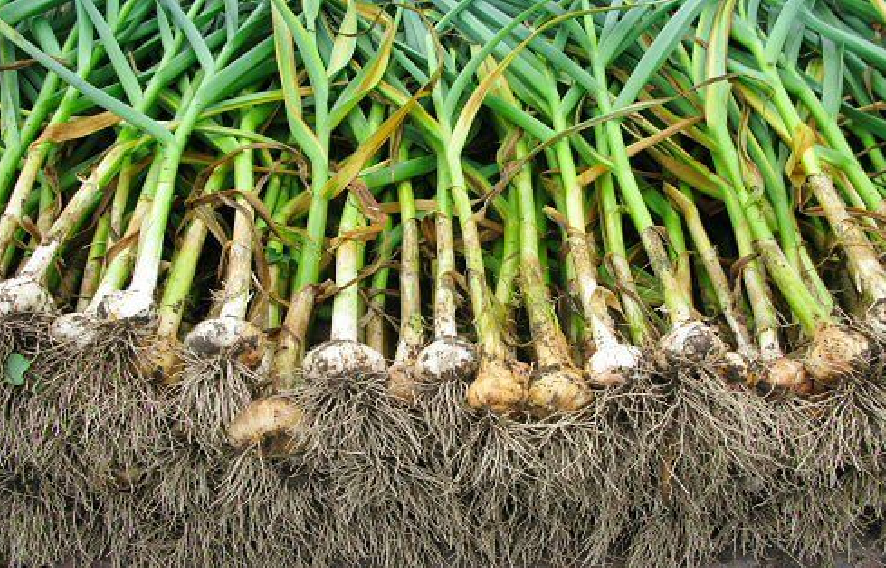Garlic is a familiar and highly valued plant known for both its sharp, spicy flavor and powerful medicinal properties. A garlic bulb, the most commonly used part, is divided into small fleshy sections called cloves. These cloves serve culinary, medicinal, and even seed-growing purposes.
The leaves, stems (known as scapes), and immature flower heads (bulbils) are also edible, typically enjoyed when tender. The papery skins and attached roots are the only parts not consumed. Though its exact origin is uncertain, garlic is believed to have come from Central Asia and belongs to the larger Allium genus, which has over 700 species — many native to the Himalayan region and Turkestan.
Chemical Properties & Constituents
The therapeutic power of garlic comes primarily from its sulfur-containing compounds, especially allicin, which gives garlic its strong aroma and many of its health benefits. Allicin is formed when garlic is crushed or chopped, activating an enzyme called allinase, which converts alliin into allicin. This compound then breaks down into other bioactive molecules like ajoene and vinyldithiines.
Key Chemical Compounds in Garlic:
-
Sulfur Compounds: Alliin, Allicin, Ajoene, Diallyl disulfide, Diallyl trisulfide, Allylcysteine, Vinyldithiines, S-allylmercaptocysteine
-
Enzymes: Allinase, Peroxidase, Myrosinase
-
Amino Acids: Arginine and its glycosides
-
Minerals: Selenium, Germanium, Tellurium, Magnesium, Zinc, Phosphorus, Calcium, Copper
-
Vitamins: Vitamin A, Vitamin C, Vitamin B6, Thiamine (B1)
-
Others: Anthocyanins, Glycosides of kaempferol and quercetin, Polysaccharides, Volatile oils
Notably, garlic has a higher concentration of sulfur compounds than any other Allium species.
Nutritional Profile
Garlic is not just medicinal but also highly nutritious. It is:
-
An excellent source of manganese
-
A very good source of vitamin B6 and vitamin C
-
A good source of protein, thiamine (vitamin B1), and essential minerals like selenium, phosphorus, calcium, potassium, and copper
These nutrients, especially the sulfur compounds, act as powerful antioxidants and anti-inflammatories, playing key roles in disease prevention and overall well-being.
Therapeutic Uses of Garlic
Garlic’s reputation as a natural healer is backed by both traditional wisdom and modern science. Here’s a detailed look at its therapeutic actions:
-
Anthelmintic: Destroys or expels intestinal worms and parasites.
-
Antibacterial: Kills bacteria without harming the body's natural intestinal flora.
-
Antibiotic: Acts as a natural, broad-spectrum antibiotic.
-
Anticancer: Possesses compounds that inhibit tumor growth and cancer cell formation.
-
Anticoagulant: Prevents blood clots, reducing the risk of strokes and heart attacks.
-
Antioxidant: Neutralizes free radicals that contribute to aging and chronic diseases.
-
Antiseptic: Disinfects wounds, cuts, and skin infections.
-
Antispasmodic: Relieves muscle cramps and spasms.
-
Antitumor: Prevents or slows tumor development.
-
Antiviral: Fights against viruses, including those causing colds and flu.
-
Blood Thinner: Reduces the risk of clots by thinning the blood.
-
Carminative: Eases indigestion and expels gas from the digestive tract.
-
Cholagogue: Stimulates the flow of bile for improved digestion.
-
Diaphoretic: Promotes sweating to help cool the body and flush toxins.
-
Digestive: Strengthens and stimulates the digestive system.
-
Diuretic: Increases urine production, aiding in toxin elimination.
-
Expectorant: Helps clear mucus from the respiratory system.
-
Febrifuge: Reduces fever.
-
Stimulant: Boosts overall energy and metabolic activity.
-
Stomachic: Tones and strengthens the stomach.
-
Tonic: Restores and invigorates bodily systems.
-
Vasodilator: Widens blood vessels, improving circulation and lowering blood pressure.
Traditional & Modern Medical Applications
-
Infections: Garlic juice applied externally is a powerful antiseptic for wounds.
-
Digestive Disorders: Used to treat ringworm, Candida, vaginitis, and parasitic infections.
-
Respiratory Health: Acts as an expectorant and relieves cough, bronchitis, and asthma.
-
Heart Disease: Lowers cholesterol, reduces blood pressure, and prevents arteriosclerosis.
-
Diabetes: Regulates blood sugar and slows the development of complications.
-
Detoxification: Helps remove heavy metals like lead from the body.
-
Cancer Prevention: Garlic has shown inhibitory effects on various cancer cells in lab studies.
-
Folk Remedies: Widely used in traditional systems for colds, earaches, insect stings, digestive troubles, and even to repel pests.
Scientific Insights
Recent research confirms garlic’s ability to:
-
Reduce vascular calcification in patients with high cholesterol.
-
Generate hydrogen sulfide (H₂S) in the body, a gas that acts as a natural cardiovascular protector and signaling molecule.
-
Provide broad-spectrum antimicrobial action against viruses, bacteria, fungi, and parasites.
Speech Disorder
A speech disorder, also known as a speech impairment...
ADHD
Attention-deficit / hyperactivity disorder (ADHD) is a...
Cerebral Palsy(CP)
Cerebral palsy (CP) is a group of neurological disorders...
Cancer
Cancer is a broad term for diseases where cells...




